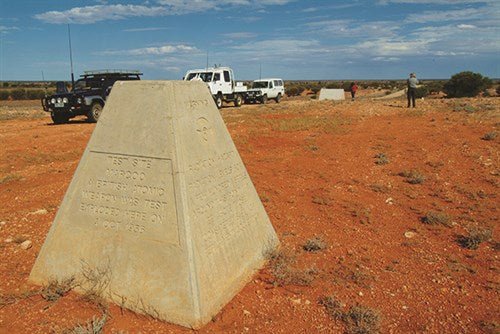
Australia's atomic bomb legacy
|
|
Time to read 2 min
|
|
Time to read 2 min
For the last couple of years, you’ve been able to do a tour of the Maralinga A-bomb test sites in the far west of South Australia, but these A-bomb sites are not the only ones you can visit in Australia.
Much further west, you can now visit the A-bomb sites scattered across the Montebello Islands, off Dampier in north-west Western Australia. Those bomb blasts were all part of the Cold War that existed after WWII and Australia did its part by allowing the Brits to let off a few big crackers in our backyard, while also establishing Woomera for the testing of their intercontinental ballistic missiles.
The first test – the first British A-bomb explosion ever – was christened Operation Hurricane. This was a 25 kilotonne bomb (Kt, or the equivalent of 25,000t of TNT) and was detonated on October 3, 1952, on board the frigate HMS Plym, which was anchored off Trimouille Island. The ship was basically vaporised but a large piece of the ship’s boiler can still be seen in the 6m-deep, 300m-long crater that exists on the ocean floor, while high flying scraps of ship’s metal can still be found on the nearby island.
The second A-bomb test in Australia, Totem 1, was at Emu in northern SA on October 14, 1953 when a 10Kt device was exploded on top of a 31m tower. Just 12 days later Totem 2, a mere 8Kt bomb, was again detonated on top of a 31m tower. Today, both sites can be easily visited by those travelling the Anne Beadell Highway.
Operation Mosaic G1 was detonated on May 16, 1956 and was a 15Kt blast set on a tower at the northern end of Trimouille Island, again in the Montebellos. The final and third test Operation Mosaic G2 was on June 19, 1956, which was detonated on Alpha Island. It rated as a 98Kt blast and remains the biggest explosion ever to happen in Australia.
While all the islands were closed off to public access for many years, you can now visit them and enjoy the fabulous fishing and diving and also check out the bomb sites and observation dugouts, along with the rusty relics that lie scattered through the low scrub.
For the easiest way to visit the islands, visit montebello.com.au for more.
In late 1956, the focus of the British A-bomb tests shifted to Maralinga, which could be accessed and supplied much easier and cheaper by the Trans-Australian Railway Line. The first test One tree was exploded on September 27, 1956, and was a 12.9Kt explosion on a tower. Within the next month, three more followed: Marcoo (1.4Kt at ground level), Kite (2.9Kt airdropped) and Breakaway (10.8Kt on a tower). The following year, three more explosions occurred: Tadje (0.93Kt tower), Biak (5.67Kt) tower) and Taranaki (26.6Kt from a balloon). For the next 10 years or so, Britain carried out a range of nuclear tests but no more A-bomb tests, although arguably, the nuclear tests left behind more contamination than the bomb tests.
Still, after much public scrutiny, debate, outrage and effort, the sites at Maralinga have been cleared up and the area is now open for travellers to visit. In fact, the local Maralinga Tjarutja Aboriginal people want visitors to come and visit but you might baulk at the price. Visit maralingatours.com.au for more information.
There’s another, lesser-known blast associated with the A-bombs in Australia that few people know about. In July 1963, a bomb, Operation Blowdown, was exploded at Iron Range on Cape York Peninsula. However, a decision had been made to simulate an A-bomb blast, using 50t of TNT sitting on top of a 140ft tower in the middle of the virgin rainforest. The lush grassy clearing, a few hundred metres in circumference, can still be seen just south of the junction on the Portland Roads to Lockhart River Road.
Go check them out and hope we never see that again!
Check out the full feature in issue #102 July 2016 of Camper Trailer Australia magazine. Subscribe today for all the latest camper trailer news, reviews and travel inspiration.